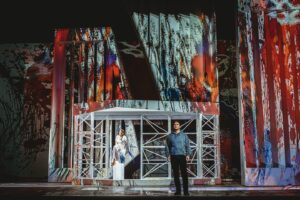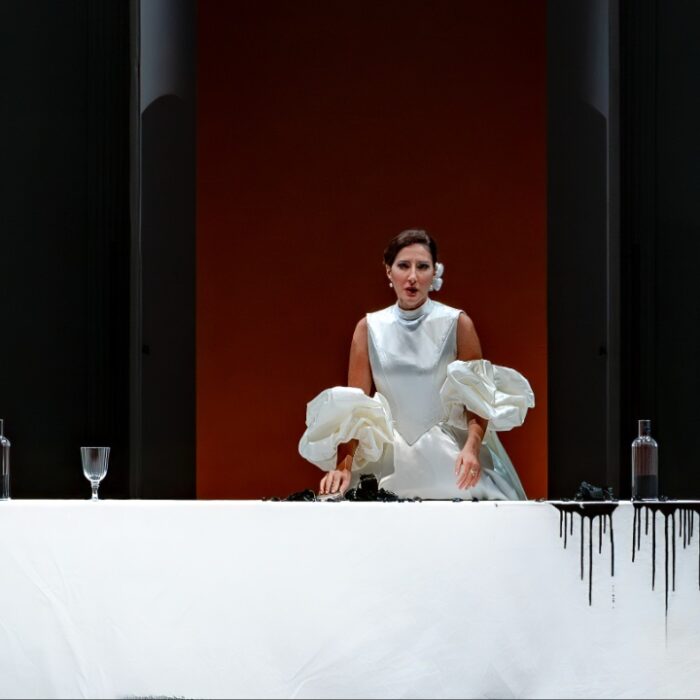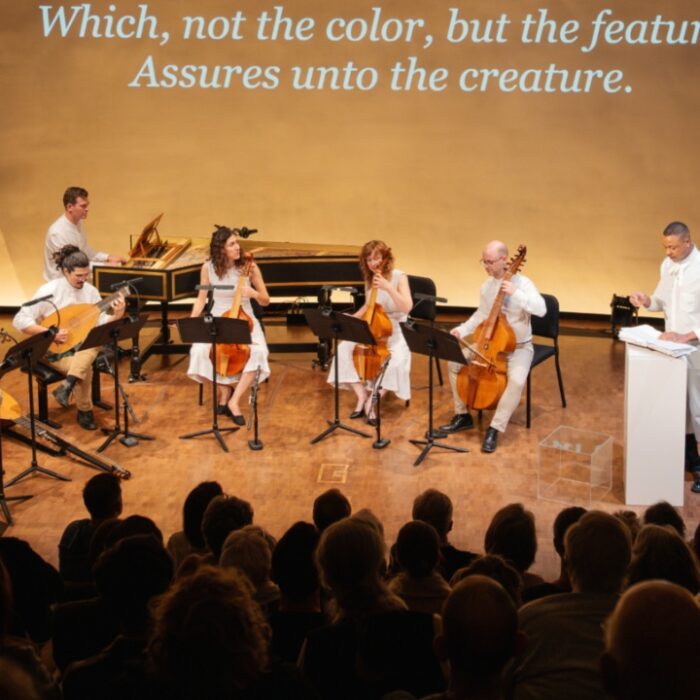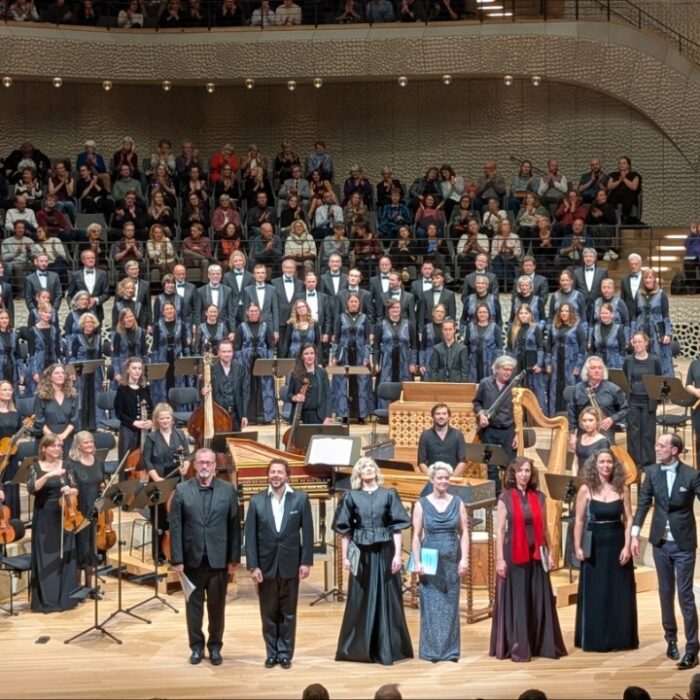
Tiroler Festspiele Erl 2024-25 Review: Parsifal
Jonas Kaufmann Gives Solid Performance in New Production of Wagner’s Work
By Lois SilversteinThe Tiroler Festspiel Erl Easter “Parsifal” was not, as some might have thought, Jonas Kaufmann’s “swan song,” either as Artistic Director or as Parsifal. Instead, the new production directed by Philipp M. Krenn, was replete with new directions, foci, trials and errors. A single lane swimming pool; a series of videos built around the landscape that housed the theater; a cast either semi-naked or adorned with hoodies and jeans that came right into the audience for the finale as the orchestra rose to stage level. There was also an animated corpse. These were just a few of the innovations. More significant, however, was the intention that drove the work from its contemplative-symbolic-sacramental mood into a contemporary active variation. With its tip of the hat to Jung, and Buddhist views of the self, and today’s perspectives on self-evolution, we found a lively and up-to-date style that no doubt met many audience needs.
The production team, including Werner Hintze (dramaturge), Thomas Achitz (video design), Regine Standfuß (costume designer), Stefan Schlagbauer (lighting designer), executed the Festspielhaus production with skillful art and commitment. For those, however, who looked for contemplative aspects for which “Parsifal” rings, the baby was sometimes lost in the bathwater, so to speak. Except for the music. Under Asher Fisch’s dynamic leadership of the Erl Tiroler Orchestra, the work regaled in its transmission, whatever perspective it aimed to communicate.
The production began with a black and white video of him running through the local landscape to the theater in a gray emblematic hoodie, jeans and running shoes outfit, the Everyman of our day. Through the course of the production, he became Parsifal, the white knight who brought redemption or transformation. The videos throughout, while provocative, kept us back too long from stepping into the dream of the story about to unfold. The video required us to react to it instead of entering the world of “Parsifal,” the opera and so de-emphasizing its universal quest. Yes, the quest is evident, whether it was self-individuation of some sort, Christian, Buddhis,t or Jungian, et al, its myriad and contemporary style and choice of actions detracted from the more universal journey. It compelled us to choose whether to be “Everyman” or the creator, a quasi-Pirandello-style approach, which also distracted.
As for Kaufmann in this production: as always, he acquitted himself notably, occasionally tender, thoughtful, caring, and innocent. His voice was mostly solid and beautiful as in the powerful moment of recognition when he sang, “Amfortas, die wunde.” His voice resounded movingly through the hall – more clasped than delicate and searching, but still with the familiar and resonant quality we have heard these many years. Likewise, his confident finale when he stood, staff in hand, leading the way with direction and intention.
Unlike some of his earlier incarnations of Parsifal himself, Kaufmann seemed less naive and unknowing, perhaps less embodied. When he entered, after having killed the swan, we watched a filmy white drape flutter off of him. Rather than a representative object, we interpret this material as the dead animal. This seemed contrived and made him seem less a child of the forest and the elemental. Consequently, the moment, so rich with feeling, seemed “performed” and less embodied. While appearing as the swan, as it were, draped in white curtain material, he seemed somewhat contrived, created rather than grown. Yes, he reached his goal but in an emotionally syncopated fashion. Because Kaufmann is such a strong performer, he convinced us, but it became a challenge to feel with Parsifal while we were watching Kaufmann (in a hoodie), and not to forget him as Jonas Kaufmann. The good part of that was the Everyman idea: that we also were Parsifal and the performer. Yes, a good idea. Did it always work? No. That was a disappointment. Perhaps the videos needed shortening. Perhaps the ingenuity of camera work could have been cut as well as keeping the story emotionally deep.
A highpoint, however, of Kaufmann’s performance was his interactions with Kundry, performed with style and intelligence by American soprano, Irene Roberts. The two spent a good deal of time making significant contact, be it a glance turning into a gaze, though less spontaneously than driven by their intention to prove something to each other, or moving from one stage of development to another. Physically active, flexible and dexterous, vocally strong and intense. As Kundry, she played the leadership role, willing to lead the “fool” to his rightful destiny, determined not to allow him the ease of passivity. She sang with a strong and deliberate determination and color. Roberts was powerful and independent, her voice determined, strong, and lustrous. Her voice supported her acting more than the other way around. The whys and wherefores of her disappearance at the end remained unexplained and lacking. Kundry gone? And the somewhat extended sequence of her washing Parsifal’s feet and changing of his clothes from nearly naked body to white garb seemed too long as well as extra.
Brindley Sherratt as Gurnemanz sang with lustrous beauty. His articulation was immaculate. Another gift of this production was how he managed to keep his long speeches to remain free from long-windedness. He moved easily on the stage, remarkably lifting the longer speeches into more human rather than tendentious expressions. So too, Michael Nagy as Amfortas, who even in wheel chair, managed to move smoothly around while articulating his pain and grief.
Georg Nigl as Klingsor performed dutifully, not overly dramatically but skillfully. This remained true for Titurel as well, Clive Bayley giving a strong performance. The gesturing of Titurel as a corpse seemed excessive, and many times, taking what seemed like a traditional gesture of slapping the floor to the point of mild mockery. Again, the emphasis is on a dramatic thing to do, but lacking interior truthfulness. The Chorus performed well, giving a good impression without more numbers. The Flower Maiden sequence included delicately designed movement in effective costumes, harmonizing well with that of Parsifal.
The ups and downs of the performance, what seemed like multi-climaxes rather than a continuous dramatic whole, except in idea, left the performance a bit too self-conscious. The idea reigned rather than the deeper message. However, the rising of the orchestra, the entrance into the audience of the cast, the raising of the lights – these emphasized the direction the work aimed at – how to include all of us in the drama and make it our own. The richness of method, the skills of the performers, the unity of intention brought the audience into the performance and the performance into the audience might very well be a project of Jonas Kaufmann’s intent to bring opera more into the world today, as it tends to recede into the world of television, video, computer screens and canned streaming. This is a worthy and mighty effort. May it be so.


